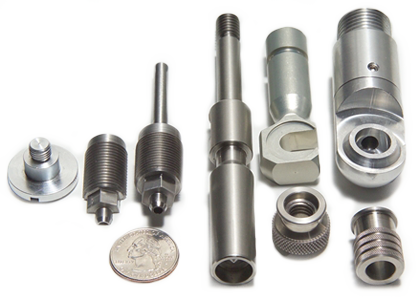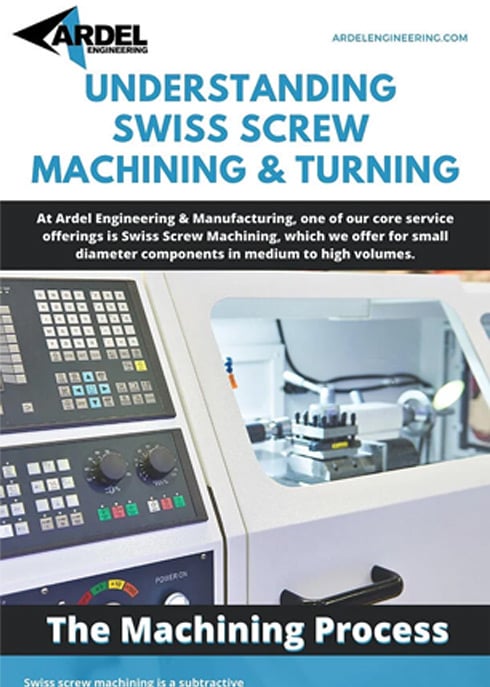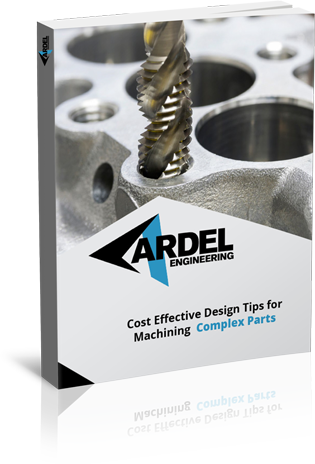Swiss screw machining is a subtractive manufacturing (i.e., machining) process that employs the use of Swiss-type machining equipment. It differs from other machining equipment in that it uses a guide bushing to minimize the distance between the main spindle and the cutting tool. This design difference results in less bending of the workpiece and, consequently, deflection at the cutting surface. The process is often used for the precision manufacture of small cylindrical parts and products in high volumes.

At Ardel Engineering & Manufacturing, we specialize in precision CNC machining services. One of our core service offerings is Swiss screw machining, which we offer for small diameter components in medium to high volumes. Below we provide an overview of the Swiss screw machining process, outlining the basic process and typical parts produced, key manufacturing advantages, industrial applications, and the extent of our capabilities.
understanding swiss screw machining & turning
LEARN MORE ABOUT
- High volume production
- Benefits over other machining & manufacturing processes
- Industries and common uses
An Overview of
the Swiss Screw Machining Process
At the beginning of a Swiss screw machining operation, raw material (typically bar or rod stock) feeds into the machine. The headstock clamps onto the material and spins and slides it through a guide bushing into the tool zone, where all of the cutting processes take place. Some operations employ multiple spindles to work with different cutting tools during a single cycle, enabling efficient production of highly complex components.
Parts and products manufactured through the Swiss screw machining and turning processes are small (typically less than 1.25 inches in diameter), cylindrical, and precise. They can be made from a broad selection of metal and non-metal materials, such as metals (e.g., aluminum, brass, and stainless steel), plastics (e.g., PEEK, Delrin and Acetal) and Alloys (e.g., Titanium and Inconel).
Advantages of
the Swiss Screw Machining Process
Compared to other machining and manufacturing processes, Swiss screw machining offers a number of benefits, such as:
- Greater design versatility: Swiss screw machines can create components that are too expensive or otherwise impossible for traditional machining and manufacturing techniques, such as very small or complicated screws with multiple surface features.
- Broader material suitability: The Swiss screw machining process accommodates a wide range of metal and non-metal materials, all of which can be formed with extreme precision. Additionally, the same machine can be configured and reconfigured to process different materials depending on part and production specifications. This versatility allows clients to be selective with their material choices and choose the one that best fits their project.
- Lower level of deflection: During Swiss screw machining operations, the distance between the workpiece support and the cutting is minimal, which results in less bending in the workpiece and deflection at the cutting surface. This process quality allows manufacturers to achieve tighter tolerances in the machined components.
- Higher production efficiency (at high volumes): Once configured and loaded, a Swiss screw machine can run autonomously, minimizing the amount of operator involvement required. Since the machines can contain multiple spindles and cutting tools, a single pass is often sufficient to create near-net components. Better cost-effectiveness: The Swiss screw machining process allows for the production of precision components in large quantities that often need little to no secondary finishing.
- Wider range of cutting tools: Swiss screw machines can incorporate various cutting tools to perform different machining operations and achieve different elements on the workpiece.
- Higher level of control: While the Swiss screw machining process inherently allows for the manufacture of precision parts and products, integrating CNC technology into the equipment enables manufacturers to achieve even tighter tolerances with a lower chance of production error.
Applications of Swiss Turned Parts
The Swiss screw machining process can be used to create a wide range of standard and custom cylindrical components, such as fittings, screws, and shafts. The precision and accuracy it offers make it highly suitable for the production of critical parts, including for industries with strict quality standards.

Aerospace & Aircraft
In the aerospace industry, companies demand the utmost precision in their parts and products.
READ MORE +

Commercial
Swiss screw machining was first developed as a method of creating precise watch components,
READ MORE +

Communications
Contacts, connectors, and fasteners are all common in electronic and communications devices.
READ MORE +

Medical
Another industry with strict quality and safety standards is the medical industry.
READ MORE +






